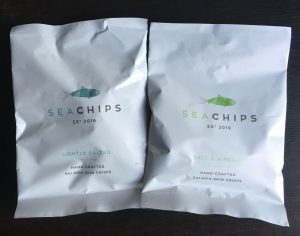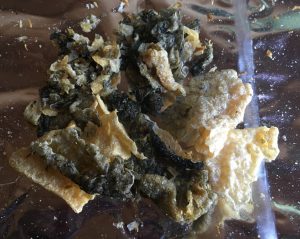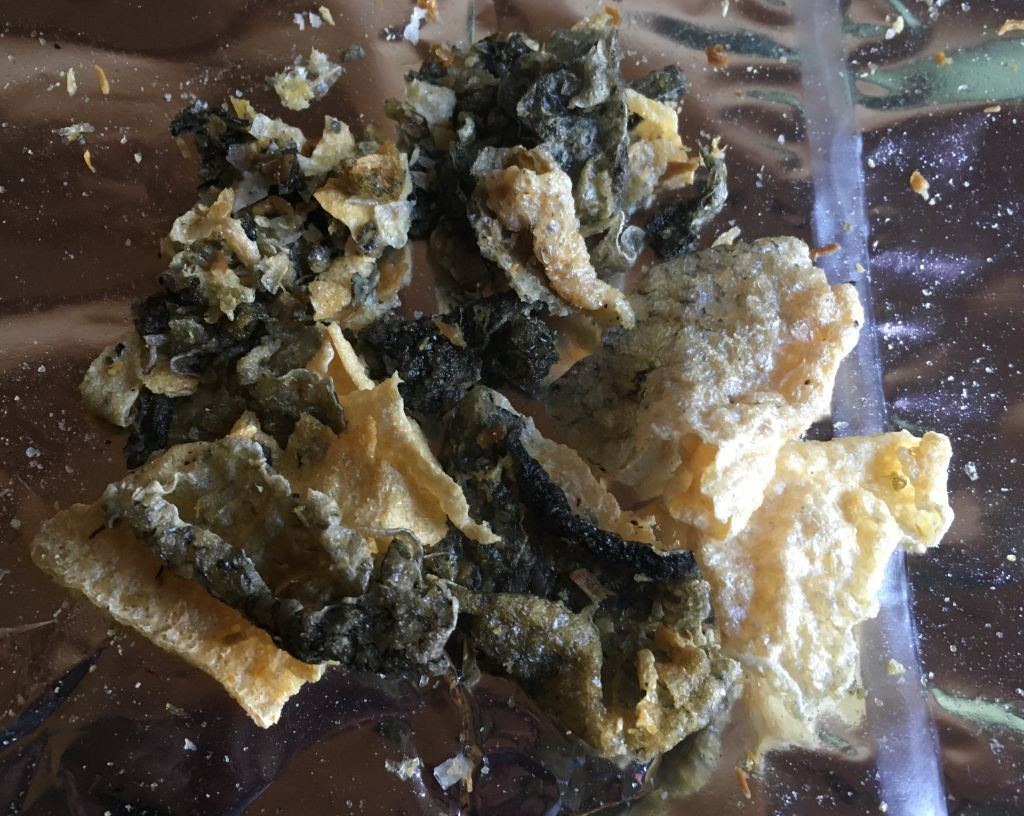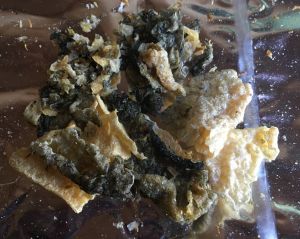Salmon consumer: Salmon farming industry critics, the Scottish Salmon Think Tank say on their website that they aim to provide straight information, opinion free so people can make up their own minds about the controversial fish farm issue. They have also written that they have exposed anomalies about the salmon farming industry on Twitter and this is where we came across the Tweet ‘Labelling salmon and the Roulé Experiment – a consumer’s perspective by Dr James Merryweather. https://salmonaquaculturescotland.wordpress.com/2018/09/05/labelling-salmon-the-roule-experiment/ This links to a blog on the Salmon Aquaculture Reform Network Scotland website.
Like, Dr Merryweather, we too like to highlight anomalies and would point out that his blog is full of them. For example, he describes his account as a consumer’s perspective, but given that he has said he would never eat farmed salmon, he cannot really describe himself as a consumer.
Dr Merryweather begins his consumer view by saying that the labelling of farmed, so called ‘Scottish salmon’ has recently been refined. He says that not very long-ago farmed salmon was proudly labelled as ‘farmed’. However, he now claims that labels just refer to the fish as ‘Scottish salmon’ and any reference to it being farmed has been removed from the front label. He says that this is clever marketing of an increasingly unpopular product.
Unfortunately, Dr Merryweather’s view is being expressed through his preconceived blinkers. We, at Callander McDowell have been monitoring labels for many years and most stores have never described the fish as ‘Farmed Salmon. One exception is the Coop who did label their fish as ‘Farmed Salmon’ but they changed this labelling quite some time ago, not recently as Dr Merryweather suggests. Those retailers that source all their salmon from Scotland do label their salmon as ‘Scottish’, but others just label it as ‘Salmon’.
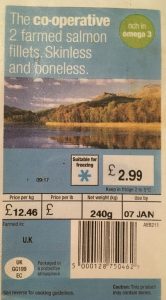
Dr Merryweather has posted a picture of part of a label from a pack of salmon bought from Aldi that states ‘2 boneless Scottish salmon fillets’ to support his claim. Interestingly, the label on the salmon packs in our local Aldi store just state ‘2 boneless salmon fillets’ not ‘Scottish salmon fillets’. Instead, the labels are overprinted with the salmon’s origin, which is either Norway or Scotland.
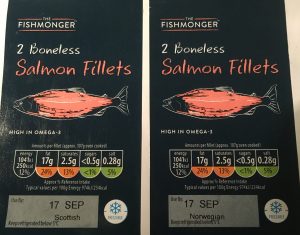
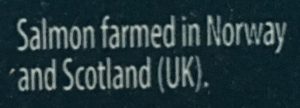
Dr Merryweather also says that before the word ‘farmed’ disappeared from the front of packs, they also included the wording ‘Farmed in Scotland or Norway’ on the label. They still do as it is a legal requirement. Yet, Dr Merryweather says – ‘yes Scottish salmon farmed in Norway’ implying that packs labelled as Scottish salmon also include a statement giving a choice of origin. The reality is that packs that state Scottish salmon say Farmed in Scotland whilst those that omit the origin as part of the product name then state ‘Farmed in … ‘ listing the alternatives if the salmon is sourced from more than one origin. We presume that if Dr Merryweather has seen packs labelled as ‘Scottish salmon’ that also claim to be ‘Farmed in Norway’, he would have reported this to his local Trading Standards officer. Dr Merryweather may suggest that packs are labelled in this way, but we would challenge him to provide evidence to support his claim.
The difference in labelling of the pack illustrated by Dr Merryweather and the one from our local store is down to the fact that retailers have been encouraged to highlight the Scottish provenance of foods sold in Scotland. This includes salmon and whilst some retailers source only from Scotland and therefore use the same packaging throughout the UK, others such as Aldi do not.
This is not part of some conspiracy to hoodwink consumers into thinking they are not eating farmed salmon as Dr Merryweather seems to suggest. The reality is that labelling of farmed salmon is no different to that of any other farmed fish. For example, packs of sea bass sold by Aldi are not labelled as ‘Farmed sea bass’ but rather just ‘Sea Bass’. The back of the pack will carry the declaration that the sea bass is ‘Farmed in Turkey’.
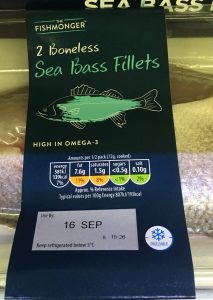

It is also worth mentioning that whilst Dr Merryweather describes salmon as an increasingly unpopular fish, the latest Neilsen data shows that 52,546 tonnes of salmon have been sold at retail compared to second place cod with 47,606 tonnes.
Dr Merryweather devoted the second part of his consumer perspective to a smoked salmon product he bought from Aldi. Whether we would describe this as a smoked salmon product is questionable since its main ingredient (87%) is full fat soft cheese. The smoked salmon content is just 10%. The product is named as Full Fat Soft Cheese with Smoked Wild Salmon and Dried Dill. The Mini Roulé also comes in other varieties; Garlic & Herb, Almond and Pineapple, Black pepper and Paprika. The 100g packs sell for just 85p, which is well below even the cheapest smoked salmon product on offer. Dr Merryweather says that the pack is boldly labelled with the words wild smoked salmon. We are not sure whether we would agree although the words wild smoked salmon are clearly visible.
Dr Merryweather says that this labelling set him thinking that it seems fine to advertise that the salmon is wild on the packs, but not for farmed. He thinks that this is because the public is becoming increasingly concerned about farmed as they did about battery hens. He couldn’t be more wrong.
It is unclear if Dr Merryweather is aware that the salmon promoted as wild in the UK are Pacific species and very different from our own Atlantic salmon. The main difference between the species is that Atlantic salmon can head back out to sea after breeding whereas Pacific salmon all die. There are five different species of Pacific salmon which are all very distinct as well as having a hierarchy in terms of their taste and eating quality. The best is Chinook, but it is rarely seen on this side of the Atlantic, then there is Sockeye, Coho, Pink and Keta.
Pacific salmon has been imported into the UK for many years. Most consumers would be familiar with it because it was shipped from Canada and the US in cans. The fish was labelled by colour Red – Sockeye, Medium Red – Coho and Pink. In recent years, sales of canned salmon have declined rapidly. Modern consumers don’t want cans of fish complete with skin and bones. More fish is consumed in the UK as chilled and the US exporters began to realise that if they wanted to maintain their market share, they would have to widen their offering from cans to chilled. In the early days, supplies were hit and miss and could have been Sockeye or Coho, so the packs were labelled generically as Alaskan salmon. To distinguish this fish from home grown Atlantic salmon, the fish was labelled as wild. This is what happens in the US, so it was natural to continue such promotion here too. Certainly, there was some confusion with consumers thinking that the fish was the same as locally produced fish but as the market developed, the fish has been increasingly labelled by its common name. These are now usually Sockeye and Keta salmon. These fish taste and eat very differently from Atlantic salmon and whilst Dr Merryweather implies that consumers are being hoodwinked into buying farmed, the reality is that the consumer choice is between Pacific or Atlantic salmon in much the same way consumers choose between cod and haddock.
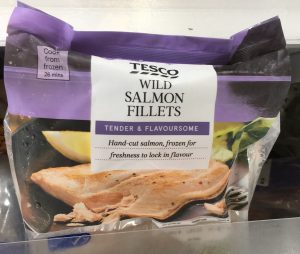
Given that the Aldi Mini Roulé was made from wild Sockeye salmon, Dr Merryweather didn’t seem to like it. He describes spreading it on bread like cream cheese (not a surprise) with farmed-salmon-coloured juice in it, which didn’t mix or stay separate but rather smudged randomly looking rather unappetising. We are not sure what he expected when he tried to spread it or expected for the price. He said that the salmon surely wasn’t a slice of smoked salmon but rather a micro thin- layer of pink sludge rolled up in cream cheese. He says that it was not particularly pleasant, but he suspects that this was because of his suspicions of the fish. We are not sure what suspicions he had other than Aldi might be hoodwinking him and that the salmon was not all it seems. We have examined the smoked salmon used in the Aldi Mini Roulé and it is a smoked salmon pate rather than a slice of smoked salmon and when tasted on its own, it tastes clearly of smoked salmon. We are not sure what Dr Merryweather would expect to be used in a product costing just 85p.
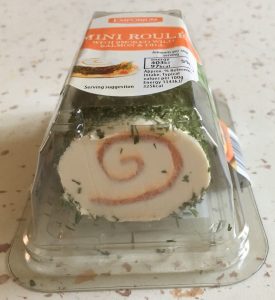
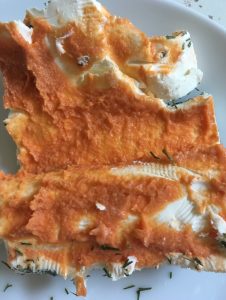
It seems that Dr Merryweather doesn’t know which way to turn. He doesn’t like farmed salmon but the wild salmon that organisations such as Seafood Watch and Marine Conservation Society say is a better choice was not at all to his liking.
He therefore poses the question whether it is reasonable for consumers like him to be actually eating the Pacific salmon that is available in UK supermarkets. He says that wild populations of most of the world’s salmon are now facing extinction or have been reduced to levels that forbid our eating them thanks to fish farm generated sea lice and diseases. Should Alaskan wild salmon now be off limits he asks?
Dr Merryweather appears to have succumbed to his own hype and lays the blame on declining stocks with salmon farming irrespective of whether salmon farming is even present. He seems unaware that salmon farming is banned in Alaska so there is little chance of Alaskan salmon being threatened by sea lice and diseases originating from farms salmon farms. He also seems unaware that many Alaskan salmon populations are enhanced by hatchery reared (aka farmed) smolts. There seems little chance of Alaskan stocks of wild salmon heading towards extinction.
We suspect that Dr Merryweather has been reading the views of Alexandra Morton who claims local Canadian stocks of Pacific salmon are under threat from farms. However, there is another train of thought that suggests that these southern stocks are having to compete for food with the many millions of hatchery reared salmon from around Alaska and are losing the battle.
Perhaps, next time Dr Merrweather wants to give his consumer viewpoint on salmon he travels to a larger town with stores that sell wild salmon either off the counter, in chilled or smoked form. Alternatively, if he would like to forward us his address, we’ll have some sent.
However, if Dr Merryweather is concerned about the state of wild salmon stocks, there is a simple solution. He should join the many millions of consumers who choose to eat farmed salmon.
And more labelling: Anti-salmon farming “expert” Corin Smith has posted on his Facebook page that ‘Marks & Spencer have suddenly stopped telling consumers where their farmed salmon comes from. This prevents consumers checking whether or not their salmon comes from farms that are meeting standards on environment and welfare’. His claim is based on the observation that a pack of smoked salmon ribbons dated 15th September carries the name of the farm at Fiunary – Sound of Mull, whilst a pack of whisky smoked salmon dated 23rd September makes no mention of the farm.
However, we suspect that he was so keen to publicise his discovery that he didn’t bother to double check and then reflect on his observation. We simply visited our local M&S store to understand what Mr Smith had seen. Of course, it helps having knowledge of the sector and an unwillingness to jump to conclusions.
Anyone following the fish and seafood market in Scotland would be aware of one major story that has dominated the industry. This is the closure by Young’s of the Pinney’s processing plant in Annan. The last salmon for M&S has now been despatched and the plant closed. This means that processing has been transferred elsewhere. A simple check of the EU processing code on the two packs of smoked salmon would show that they were produced in different plants. We suspect that the new processor has not yet set up the facility to overprint the name of the farm on the new packs. By comparison, the new processor of packs of chilled salmon clearly has, as the farm name continues to be displayed on these packs.
This assumption that M&S has removed the name of the farm from their packs of salmon in order to avoid scrutiny is typical of an anti-salmon lobby that is too quick to jump to conclusions without proper investigation.
Blackwater Response: Following last week’s mailing, Lewis Chessman (who was mentioned in the commentary) posted a response on a salmon fishing forum website. He writes that as he knows we are aware of the forum, he invites us to join and defend our views. Actually, we don’t follow any angling forum, but his comments were sent to us and we are more than happy to reply.
- River temperatures
Lewis Chessman (LC) says that our reference to the 27’5oC temperature in the River Gairn that was recorded by the James Hutton Institute is misleading because the Isle of Lewis is subject to a different climate and then refers to the air temperature. He adds that the Fishery Trust biologist took the temperature in the sea pool in late July and it was just 16oC.
The point being made was that this summer was unusual across Scotland and water temperatures had increased. In shallow water, such as the Blackwater sea pool, temperatures can change quite quickly up and down, stressing the fish. LC suggests that the water temperature was low, yet after speaking to various people on Lewis, Joe Crowley told The One Show says that the salmon industry had experienced warmer water temperatures during the summer and consequently lice had reproduced more quickly. Surely, if the salmon in Loch Roag were experiencing higher temperatures, then the salmon in the sea pool were too.
- Oxygen levels
LC seems to agree that oxygen levels in the sea pool could have been lower than normal. He says that he saw no dead brown trout whilst he was there only salmon. We suspect that the implication is that only the salmon had lice and thus were dead, although as brown trout are freshwater fish, we would not expect any to be seen in the sea pool.
- 2012
LC says that in 2012 no fish died even though fish were trapped in the pool. Whilst, there may have been a lack of rain, the summer was nothing like this year.
- Catching and killing fish
Our comments related to the mindset of the wild fish sector, not the conservation regulations. We are well aware that category- 3 rivers are catch and release. However, concerns about the state of wild fish stocks across Scotland amongst anglers have not yet proved enough to demand the introduction of mandatory catch and release.
- 400 to 500 lice
The sea lice are like every other parasite. Their life strategy is that in a population of hosts, the parasite will attack a few in very large numbers. Mr McGilvray’s comment was that there is no other explanation to the lice load other than they came from the farm. Our premise as an alternative explanation is that fish migrated into the sea pool with a normal lice loading, but as the fish were unable to head into fresh water the fish became increasingly stressed with the changing temperatures and at the same time, the lice on the fish bred rapidly. The more the fish were stressed, the more they became susceptible to attack by the lice. There have been many recordings of fish with lice levels of four to five hundred.
- Interactions with farmed fish.
LC says that we have misinterpreted his claims that that fish had been cruising up and down Loch Roag as they were prevented from entering the river. Mr McGilvray wrote the fish started to enter the Blackwater in the first weeks in June. This is in line with his website that states fish normally enter the river in June. If the fish were cruising up and down the loch for several weeks before June, then it is likely that they were in the loch towards the end of April. As LC points out this is unlikely, as the fish return they are more likely to head for the Blackwater rather than cruising up and down the loch. The idea that fish cruise up and down only makes sense if farms are to be blamed as the source of the lice.
- Salmon catches
Mr McGilvray wrote that fish entered the system in June and fishing was only suspended in July. We presume that if lice infested fish were being caught, then photos would have been taken and publicised, but it seems that it was not until the end of July, that the situation deteriorated enough to start crying foul. This would tie in with the view that the lice loading developed in the sea pool.
- Infecting the farm
LC says that he will not honour the ludicrous proposition that lice from wild fish had spread to the farm, with a response. We would point out that when smolts are transferred to cages from freshwater they are lice free. Sea lice are a natural parasite in the environment and the only way that farmed fish become infected is from the environment.
- UDN
In our original commentary, we included some photos from the 1960’s of fish stricken with what was then called the ‘Salmon Disease’ but now known as UDN or Ulcerative Dermal Necrosis. Our photos prompted one reader to suggest that some of the lesions seen on the Blackwater fish were reminiscent of fish suffering from UDN. Although the last big outbreak of UDN occurred in the 1960s, early running adult fish have been observed in rivers such as the Spey. The Spey Fishery Boards monthly briefing for June 2012 was devoted to the disease. They say that just a limited number of fish were infected rather than it being an epidemic. In fact, they say that UDN is always present at low levels and that the higher incidence that occurred in the Spey in 2012 may be due to unusual weather conditions. Infected fish could also suffer from secondary infections such as fungus such as Saprolegnia.
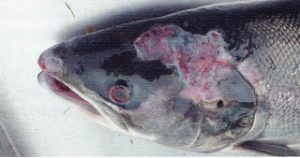
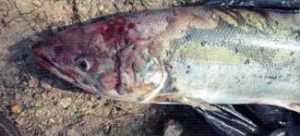
(From Spey Fishery Board Monthly Briefing 2012)
Interestingly, the Courier reported that Saprolegia was blamed for decimating stocks of salmon in the River North Esk in 2017. A spokesman for the Esk Rivers Fisheries Trust told the newspaper that ‘the sight of dead and dying spring salmon is sad and upsetting’. The salmon become stressed in low water conditions when water temperatures can increase rapidly. Incidence of the disease tends to be of the highest when large numbers of salmon are present in a small area particularly if they are prevented from moving upstream and they are presumably stressed. If the fish are stressed, then they will be susceptible to secondary infestation by sea lice.
Seemingly, these salmon deaths didn’t attract the interest of the BBC One Show. It is only when salmon farming is implicated that they become of media interest.
Fish with head lesions have apparently been seen in other rivers too.
- Paid for.
LC repeats the common misconception that we are paid by the salmon farming industry to express their views. We can only repeat yet again that no-one pays us to express any view. Anything that appears in reLAKSation is our view and our view alone.
The person who sent us the comments from Lewis Chessman said that he is from Lewis born and bred and has retired back to the island and knows every river minutely. He asks us what qualifies us to comment on the Blackwater. This is a view which we regularly encounter. Seemingly, we are not considered sufficiently qualified to discuss wild fish issues because we are not anglers but at the same time, anyone and everyone is able to criticise the salmon farming industry with total impunity.
We are still waiting for someone from the wild fish sector to explain why sea trout catches from the aquaculture zone have been in decline from 1952, but it is only salmon farming that gets the blame despite really only being present since the early 1980s.
Finally, this is a timely reminder that those who so readily blame salmon farming for declines in wild fish numbers should read the book Loch Maree’s Missing Sea Trout – now available on Amazon. We only mention it again because the wild fish sector won’t. We don’t know why they aren’t interested in this book, which after all is a subject that is so close to their hearts!
Had its chips: Salmon Business recently reported on a newish venture producing what they describe as salmon crisps. The crisps are actually dried and crisped salmon skins and are marketed as Sea Chips, handcrafted salmon skin crisps.
According to Salmon Business, the snacks are high in protein and omega-3 fats, although the packs state that they are high in protein and many of the essential nutrients commonly found in fish.
The venture is run by Dan, a 25 year old chef and his partner Dom, an accountant. They saw an opportunity to use what is otherwise waste. Fish skin snacks are apparently popular in Thailand. Sea Chips are produced in three flavours, lightly salted, salt and vinegar and lime and chilli.
The snacks are stocked in Wholefoods, Fenwick and Harrods so during a recent visit to London, we took the opportunity to buy some to taste. However, our first call to Wholefoods central London store proved fruitless as we were told that supply problems meant it was no longer being stocked at that branch. We went over to Wholefoods main store and eventually tracked down the snacks in the much larger store.
We have tasted the salted and the salt & vinegar varieties and preferred the one with added flavour. The salted version has a slightly fishy taste and a puffed up feel to the mouth. We are not sure if they will take off in the UK but not because of the unusual ingredient or the taste. The problem with Sea Chips is that whilst a typical bag of crisps (Walkers 32.5g) costs 65p (about £20/kg). a 20g bag of Sea Chips cost £1.99 (£99.50/kg). They are just very, very expensive.
